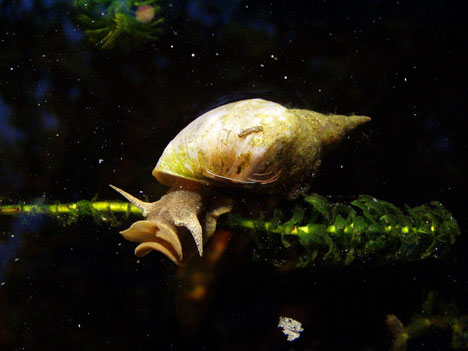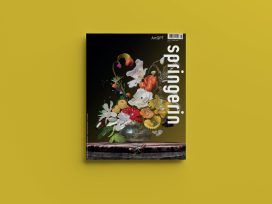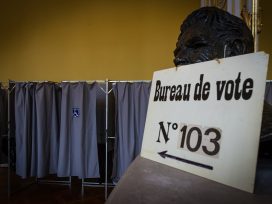“Our job is to go where everyone has gone before, but where few have bothered to linger”. This is how Ian Bogost defines the ethos of his attempt to lay the foundation for “object-oriented” phenomenology in his work Alien Phenomenology. Bogost’s study draws on Graham Harman’s version of “flat ontology”, according to which the equality of all existing things is based on their objectivity. In other words, things withdraw into themselves, appear to each other and allow themselves to be used by each other regardless of any human intermediary. As Bogost states, this does not do away with questions such as “What do they experience?” or “What is their proper phenomenology?” Even though the experience of any being remains inaccessible to another, objects “try to make sense of each other through the qualities and logic they possess”. If we think that human experience is just one mode of experience among others, we are capable of understanding the exclusiveness of each experience as well as its special way of being exclusive, in other words the logic of its experiencing. This is what Bogost’s various case studies and practical exercises tend to show. At a certain point, however, his elaboration encounters a limit, which constitutes the subject of this article. The problem concerns the possibility of “speculative ethics”: “Could an object characterize the internal struggle and codes of another, simply by tracing and reconstructing evidence for such a code by the interaction of its neighbours?” The author’s answer is in the negative: “[T]he access to ethics of objects will always remain out of reach.”
The conclusion is interesting in that it seems to originate from the basic suppositions of “object-oriented ontology”, at least in its Harmanian version. As Bogost points out elsewhere in the same study, “the inherent partition between things”, “incompatibility” and “disjunction instead of flow” are premises of object-oriented ontology. The idea is tempting but, as returned to the case of the human object, it causes problems, which do not necessarily show up insofar as we move the level of mere speculation. Object-oriented ethics is certainly unthinkable as long as we accept the human idea of ethics and, according to Bogost, all ethics remains basically human, the Levinassian ethics of “otherness” included. What about the ethics of trans-human beings, then, who are clearly neither human nor non-human, but something in-between, no matter how unstable or transitory that state may be?
Performance practices that take place on the borderline between the animal body and the human body provoke this kind of questioning. As Brian Massumi recently emphasized on the basis of his reading of Gregory Bateson’s classical essay on play, “ludic gestures” should be understood as sites of “transindividual transformation”. What does this mean on the level of bodily practice? How might it affect our theoretical and ethical understanding of what performance can do?
1. Other spaces, other species
As evidence I will use a bodily technique that radically alters human experience. The exercise originated in a Helsinki-based live art group called Toisissa tiloissa (“Other Spaces”), with which I have worked since 2004, originated the exercise. The aim of the group is to develop collective bodily techniques, or “exercises”, through which people can come into contact with non-human experiences and phenomena. The techniques may draw on existing traditions of performing but are not based exclusively on any of them. The common interest of the group members is in studying the limits and the potential of the human body, as well as in seeking new ways of encountering the public in alternative settings. The exercise itself is considered a model for performance.

Foto: Anette Arlander.
In the exercise I use as an example the performer gradually changes into a pond snail, a small invertebrate animal with a spiral-shaped shell (family: lymnaedae), which lives at the bottom of shallow fresh waters – rivers, lakes and ponds – and nourishes itself with vegetal material. The exercise is done collectively. The human gastropods move around slowly, communicating with each other via their antennas.
The virtual space or “scene” the exercise opens up for its performer is sustained by a compound of the limited number of psychophysical correspondences between the human body and the gastropod body. These correspondences or bodily tropes are easily recognized and named in the given example: a curved spine and back create the feeling of carrying a hard mantle or shell. The sliding movement and contact with the ground corresponds to the way a gastropod moves. The mouth directed towards the ground corresponds to the way a gastropod nourishes itself. The movements and humidity of the lips and the tongue represent the soft and slimy body of an invertebrate. The smacking sounds made by the mouth create an ambiance similar to underwater acoustics. The sounds also work as signals to other gastropods. The movement of the fingers correspond to that of the antennas. The movement of a gastropod is not directed by sight. It is guided partly by the search for imaginary nourishment, and partly by the movements of the whole gastropod colony.
From the biological perspective we are obviously dealing with a caricature. But that is not the point. The construction is sufficiently realistic to awaken the “gastropod in us”. The compound of psychophysical tropes works like a mimetic receptor or net, which attracts mental images or memories of actual gastropods, the places and the moments, that the performer may have met or could imagine. These individual sensory representations reinforce and sustain the bodily composition, and vice-versa. The focus of the consciousness oscillates characteristically: at moments the performer feels like a gastropod, at moments she sees herself as a gastropod. The state the exercise produces in the performer is strange and non-human, but still a sharable and transmittable human experience, it is trans-human.
In what conditions are we ready to accept the existence of trans-human experience? What does its existence prove or mean to us? The exercise raises questions and doubts concerning its basic epistemological and ontological status. Do the bodily positions and movements of the performer only imitate the corresponding functions of the gastropod? The answer depends on what we understand by “imitation”, by mimesis. The analogies between the human body and the gastropod body the exercise builds up and gathers together are not only representative but also sensorial; they not only give an image of the life of another species, they also entail corresponding corporeal affects or touches. This takes place on a level at which there is not (yet) any distinction between the human and the animal body, on the level of bones, skin, tissues, secretions and organic movements. Human bodies and the bodies of other species share a lot on the phylogenetic level. The exercise disorganizes our “body scheme”, the habitual combination of bodily tropes according to which we feel and recognize our bodies as human, and reorganizes them according to a non-human schema, which is not merely external imitation but is also internal, i.e. “psychophysical”.
It is obvious that a human body cannot share all the psychophysical features of a gastropod, but at least it can share some of them. If it could share them all it would not “become” a gastropod, it would be one!
As in all bodily play, the transformation never involves the whole body. The propotional nature of the bodily transformation means that the performer retains a certain level of human consciousness, which allows her to reflect on and control the altered state. The exercise does not engulf her like a shamanistic trance, a psychotropic hallucination or a psychotic state. On the contrary, it may help her to become better aware of the unconscious technical basis of these kinds of altered states.
What does the experience teach us about what experience is or how it subsists? According to modern empirical realism, which still dominates both scientific and everyday discourse, imagination and play are mere “functions” of the human organism. However, as the exercise itself illustrates, imagination seems to operate here with very special elements, with mimetic affects or phenomenological touches, the ontological status of which is irreducibly ambiguous. We might think that the performer here is, like any other actor, creating mental representations of previous encounters with other species, dealing with memories that he or she cannot share with anyone else. Yet, precisely because of their singular nature, these representations are never exclusively his or her “own”. Perhaps one should rather see the exercise as reactivating those initial moments of contact and reorganising them in the light of their reciprocal asymmetry, showing them now from the other side, from the point of view of the gastropod, for instance. The body of a pond snail has once touched this human body, which still carries a “trace” of that encounter. The virtual gastropod body is reconstructed from these bits and pieces of affective phenomenological evidence. The exercise is, in fact, built upon the very fact it purports to illustrate, namely that we are always and all the time much more deeply affected by and connected to our fellow creatures than we are normally conscious of. We are inhabited by other species, not only in our phylogenetic structure but also on the level of our experience, the level of consciousness of which varies. Our phylogenetic structure serves as a basis for bodily imagination, which constantly, whether we notice or not, transgresses the limits of the human organism and inhabits our bodies with non-human traces.
If, on this basis, we accept that all creatures, at least living ones, create for themselves some kind of representation of their surroundings, in other words if there is a place for “alien phenomenology” in a trans-human sense, then we should also give ourselves to the study of imagination and play in a new way. We are unable to indicate where imagination turns into bodily experience and vice versa. On the contrary, we should think of all imagination as bodily, even in our daydreams when the dreamer’s body only plays dead. The limits of human experience, if they really are limits, cannot be entirely our own: they are something that we share with what we are not. If imagination and play, as two basic dynamic aspects of experience, are able to retrace and, to some extent, remove these limits, then both activities are working in a way that also connects us with the unknown without automatically making it “known” and our “own”.
As the reader may have noticed, the “experience” I refer to here, such as in the gastropod exercise, contains nothing added from the outside onto the compound of bodily tropes: it is rather created as the sum of them. Exercise is a practised experience, in both senses of the term, lived through as a situation and a technical experiment. It has the dynamic structure of an experience. It presents the experience to itself in a conceivable and modifiable form. I have recently called forms of this kind, which can be opened up and articulated via various experience techniques, provisional absolutes. If we use our imaginative experience in a special way, technically or artistically, way may learn to construct liminal experimental spaces or vestibules, which are non-human but which we can still experience and observe. These spaces or states could be used not only for our enjoyment but also for studying dimensions that are strange to us. This would open pathways for experimentation and experimental research, for artistic research.
2. Trans-human ethics in performance
The questions the above example raises are not only theoretical, but also relate to contemporary efforts to deconstruct anthropocentricism in the arts and in society. The Other Spaces exercises, like many other corresponding artistic projects nowadays, deconstruct the anthropocentric experience from within. First, they make the anthropocentric aspects of our experience appear; second, they problematize these aspects; and third, they facilitate the alteration of experience. All this takes place in negotiation among the given cultural and historical economy of the human experience, its body schemas and ideals.
For the same reason, nothing changes once and for all, and no one can really change him- or herself alone, but only as a consequence of collective repetition and exercise.
From the traditional anthropological perspective, “becoming-animal” in performance goes back to the ritualistic origins of theatre. The ritualistic approach to animality is most obvious in artistic contexts and, for the same reason, most dubious. Even though rituals may put people in contact with non-human forces and factors, their goals are defined by the needs, fears or hopes of the human collective, which re-establishes its relation to its surroundings through the ritual. The problem of performance makers and researchers today is rather to understand how contemporary performances dealing with animality are able to break out of their ritualistic, sacrificial and anthropocentric closure. In performance contexts, most of which involve some sort of gathering of human beings, spectators and/or performers, we cannot get over the aspect I refer to as pedagogical. From this perspective, becoming an animal, plant or stone is regarded as a means of changing and developing the human way of behaving and thinking, the conditions of our individual and collective existence. The performance itself is assumed to constitute a medium for this kind of change. Above, I have tried to illustrate the nature of that transformation both in practice and in theory. Nevertheless, the ethical problem related to temporality remains: where does the transformative potential of performance lie if, after all, we turn back into humans? Could pedagogy replace ritual here?
As mentioned at the beginning of this article, the question of ethics imposes a certain limit on “object-oriented” reasoning. The radical incompatibility of all objects, their mutual “withdrawal”, seems to exclude the possibility of any sort of affective relations between them. However, as noted above in the case of the human object and the bodily imagination of which it is capable, there is no such thing as withdrawal without trace. The intimacy of objects is never impenetrable: it leaks. This leaking has a dual ontological function: it not only shows the object to others and but also exposes it to them. The exposure, in turn, comprises not only technique but also affective dynamics, which may turn out to be ethically loaded. In the case of the Other Spaces exercises for example, we should take into account all human attitudes and emotions that motivate and accompany the act of becoming trans-human, such as acquiescence, (self-)humiliation, submission, repentance, regression, reduction, shame, fear, exposedness, enjoyment, desire, transgression and collective solitude…
Many of us are familiar with these kinds of attitudes and feelings, which accompany all transformative acts regardless of whether they occur in games, artistic performances or religious (mystic) practices. Every time one enters into or exits from a play or a prayer, one has to go through a certain transformation with corresponding affective states. Instead of trying to get along with these states or diminishing their effect, considering them as auxiliary or transitory, we should rather stop and ask about their “message”: this is the right thing to do when something really happens to us. The pond snail is a non-human creature, whereas the human pond snail is in a state of bodily commitment. The challenge is not only epistemological but also ethical.
What distinguishes trans-human from religious practice in the end is the same principle that distinguishes pedagogy from ritual behaviour. The aim is not to re-establish the (lost) relationship but to change, grow and develop, to reach out towards the unknown. Unlike the modernist agenda, the path of this transformation is not built on increasing skills, knowledge and possessions, but on dismantling, disarming, deconstructing and simplifying. The trans-human states are not superior or inferior to our (all-too-) human states of mind, but they are certainly something simpler, lesser than or minor compared with our experience of ourselves as autonomous and self-same subjects. Therefore, entering trans-human areas always requires a certain courage and decidedness, just like any serious ethical action. Unlike Greco-Jewish-Christian ethics, however, it does not require heroism or sacrifice, which always goes back to dialectical self-affirmation at the expense of others. As Jacques Derrida argues, the name given to this sacrificed other has traditionally been “animal”. What we may not be able to do as humans while encountering other species, we can accomplish as trans-humans. We can, for example, interview ourselves, and each other, and listen to our testimonies of “what it is like to be a bat”, an earthworm, a gastropod or a reindeer. The becoming possible of the impossible is dependent on our acquiescence. This, in turn, is an answer to the claim of transformation that planetary crises, both on humanitarian and non-human scales, impose on our lives today. Nothing links the climate crisis to ongoing mass immigration except our political choices. In order to make those choices we need courage. The trans-human ethics we have been approaching here together with gastropods is about overcoming restraining age-old fears.








